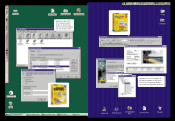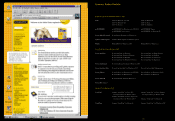Symantec 1998 Annual Report Download - page 20
Download and view the complete annual report
Please find page 20 of the 1998 Symantec annual report below. You can navigate through the pages in the report by either clicking on the pages listed below, or by using the keyword search tool below to find specific information within the annual report.
SYMANTEC CORPORATION
SYMANTEC CORPORATION 27
effective in competing with integrated
suites either currently in the market or
introduced in the future.
Quarterly Buying Patterns; Absence of
Backlog. Most customers tend to make
the majority of their purchases at the end
of the fiscal quarter, in part because they
are able, or believe that they are able, to
negotiate lower prices and more favorable
terms. This is particularly true of large
corporate customers that negotiate large
site licenses near the end of each quarter.
This end-of-period buying pattern means
that forecasts of quarterly and annual
financial results are particularly vulnerable
to the risk that they will not be achieved,
either because expected sales do not occur
or because they occur at lower prices or
on less favorable terms to the Company.
The Company operates with relatively
little backlog; therefore, if near-term
demand for the Company’s products
weakens in a given quarter, there could be
an immediate, material adverse affect on
net revenues and on the Company’s
operating results, which would likely
result in a precipitous drop in stock price.
Retail Distribution Channel. The
Company’s retail distribution customers
also carry the products of Symantec’s
competitors. These retail distributors may
have limited capital to invest in inven-
tory, and their decisions to purchase the
Company’s products is partly a function of
pricing, terms and special promotions
offered by Symantec, as well as by its
competitors over which the Company has
no control and which it cannot predict.
Agreements with distributors are
generally nonexclusive and may be ter-
minated by either party without cause.
Certain distributors and resellers have
experienced financial difficulties in the
past. Distributors that account for sig-
nificant sales of the Company may
experience financial difficulties in the
future, which could lead to reduced sales
or write-offs and could adversely affect
operating results of the Company.
New Distribution Channels. Symantec
may not be able to develop an effective
method of distributing its software prod-
ucts utilizing each of the rapidly evolving
software distribution channels, including
the Internet. The presence of new channels
could adversely impact existing channels
and/or product pricing, which could
have a material adverse impact on the
Company’s new revenues and profitability.
Site Licenses. Symantec sells volume
license programs (corporate site licenses)
through the distribution channel and
through corporate resellers. Average site
license revenue per unit is lower than the
average revenue per unit from retail ver-
sions shipped through the retail distribu-
tion channel. Symantec may increase unit
sales under volume licensing programs in
the future, which could have a material
adverse impact on the operating results of
the Company. Additionally, Symantec’s
products may not be effective in competing
with products either currently in the
market or introduced in the future, and
the Company’s failure to compete effec-
tively could have a material adverse impact
on the operating results of the Company.
Channel Fill. The Company’s pattern of
net revenues and earnings may be affected
by “channel fill.” Distributors may fill
their distribution channels in anticipation
of price increases, sales promotions or
incentives. Inventories may be decreased
between the date Symantec announces a
new version or new product and the date
of release, because distributors, dealers
and end users often delay purchases, cancel
orders or return products in anticipation
of the availability of the new version or
new product. The impact of channel fill
is somewhat mitigated by the Company’s
deferral of revenue associated with inven-
tories estimated to be in excess of appro-
priate levels in the distribution channel;
however, net revenues may still be mate-
rially affected favorably or adversely by
the effects of channel fill, particularly in
periods where a large number of new
products are simultaneously introduced.
Channels may also become filled sim-
ply because the distributors do not sell
their inventories to retail distribution or
end users as anticipated. If sell-through
does not occur at a sufficient rate, dis-
tributors will delay purchases or cancel
orders in later periods or return prior
purchases in order to reduce their inven-
tories. While such order delays or
cancellations can cause fluctuations in
net revenues from one quarter to the
next, the impact is substantially mitigated
by the Company’s deferral of revenue
associated with inventories estimated to
be in excess of appropriate levels in the
distribution channel.
Product Returns. Product returns can
occur when the Company introduces
upgrades and new versions of products or
when distributors have excess inventories.
Symantec’s return policy allows its dis-
tributors, subject to certain limitations,
to return purchased products in exchange
for new products or for credit towards
future purchases. End users may return
products through dealers and distribu-
tors within a reasonable period from the
date of purchase for a full refund, and
retailers may return older versions of
products. The Company estimates and
maintains reserves for product returns.
However, future returns could exceed the
reserves established by the Company, which
could have a material adverse affect on
the operating results of the Company.
Foreign Operations. A significant portion
of Symantec’s revenues, manufacturing
costs and operating expenses is transacted
in foreign currencies. As a result, the
Company’s results may be materially and
adversely affected by fluctuations in cur-
rency exchange rates, as well as increases
26
adverse affect on the trading price of the
Company’s common stock. This may
occur again in the future.
Rapid Technological Change and
Development Risks. The Company par-
ticipates in a highly dynamic industry
characterized by rapid change and uncer-
tainty related to new and emerging techno-
logies and markets. The recent trend to-
ward server-based applications in networks
and applications distributed over the Inter-
net could have a material adverse affect on
sales of the Company’s products. Future
technology or market changes may cause
certain of Symantec’s products to become
obsolete more quickly than expected.
The use of a Web browser (running
on either a PC or network computer) to
access client/server systems is emerging
as an alternative to the traditional desktop
access through operating systems resident
on personal computers. Should the func-
tionality associated with such system access
reduce the need for Symantec’s products,
the Company’s future net revenues and
operating results may be adversely affected.
Personal Computer and Hardware
Growth Rates. Fluctuations in customer
spending from software to hardware as
the result of technological advancements
in hardware or price reductions of hard-
ware have in the past, and may in the
future, result in reduced revenues which
would have a material adverse affect on
operating results.
Operating System. The release and sub-
sequent customer acceptance of current
or enhanced operating systems are par-
ticularly important events that increase
the uncertainty and volatility of
Symantec’s results. Should the Company
be unable successfully or timely to
develop products that operate under
existing or new operating systems, or
should the functionality of such operat-
ing systems reduce the need for
Symantec’s products, the Company’s
future net revenues and operating results
would be materially adversely affected.
Microsoft has incorporated advanced
utilities including telecommunications,
facsimile and data recovery utilities in
Windows 95 and may include additional
product features in Windows 98 or
future releases of Windows NT that may
decrease the demand for certain of the
Company’s products, including those
currently under development.
Additionally, as hardware vendors incor-
porate additional server-based network
management and security tools into net-
work operating systems, the demand
may decrease for certain of the Company’s
products, including those currently
under development. Also, Symantec’s
competitors may license certain of their
products to Microsoft and OEMs for
inclusion in their operating systems,
which may reduce the demand for certain
of the Company’s products.
Microsoft Windows 98. With the antici-
pated introduction of Microsoft’s
Windows 98 operating system, the
Company’s ability to generate revenue
from many of its current products will
depend on its ability to develop new ver-
sions and enhancements of those products
in a timely manner for the Windows 98
operating system. Because the Department
of Justice and various state entities have
filed lawsuits against Microsoft which
may delay the introduction of Windows
98 or change the interfaces or feature set
that will be incorporated into Windows 98,
the Company’s ability to develop appro-
priate products for Windows 98 may be
impeded, and consumers may delay pur-
chases of the Company’s products or
otherwise change purchase plans in a
manner that could adversely affect the
Company and its financial results.
Adverse effects related to these events
could become apparent as early as the
June quarter of 1998.
Dependence on the Internet. Critical
issues concerning the commercial use of
the Internet, including security, reliabil-
ity, cost, ease of use, accessibility, quality
of service and potential tax or other gov-
ernment regulation, remain unresolved
and may affect the use of the Internet as
a medium to support the functionality of
the Company’s products, as well as to
distribute software. Should the Company
be unable to incorporate changes in the
Internet environment successfully or
timely into its business operations and
product development strategy, the
Company’s future net revenues and oper-
ating results may be adversely affected.
Price Competition. Price competition is
sometimes intense for certain products in
the microcomputer software market and
is expected to continue to increase and
become even more significant in the
future, resulting in reduced profit margins.
Should competitive pressures in the
industry continue to increase, Symantec
may be required to reduce software
prices and/or increase its spending on
sales, marketing and research and devel-
opment as a percentage of net revenues,
resulting in lower profit margins. These
actions may not be sufficient to offset
the impact of price competition in the
Company’s business and net revenues.
Integrated Suites. In the future,
Symantec and/or its competitors may
move toward providing integrated suites
of products. The price of integrated
suites could be less than the sum of the
prices of individual products included in
these suites when such products are sold
separately. The sales volume contribu-
tion to Symantec from integrated suites
may not be sufficient to offset the gross
margin impact of selling individual prod-
ucts at a reduced price using integrated
product suites. Additionally, integrated
suites may not achieve market acceptance
and the Company’s products may not be
























